BALTIC CRUISE & BERLIN VISIT By Tim Williams (Article)
January 2010 Baltic Cruise and Berlin Visit
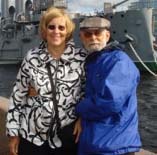 One of our most agreeable holidays in recent years was our cruise to various Baltic countries from June 1-11, 2010, and a subsequent six days in Berlin.
One of our most agreeable holidays in recent years was our cruise to various Baltic countries from June 1-11, 2010, and a subsequent six days in Berlin.
We embarked on the cruise with some trepidation, this being our first one. Would shipboard life be unpleasantly crowded? Would shore tours and outings be so hurried as to be unpleasant? Would bad weather intervene? In the event none of our fears turned out to be justified. Perhaps we were lucky but the success of the trip bodes well.
The Princess liner, an immense affair worthy of television dream dramas, seemed new and comfortable. Our cabin was small but clean and functionally adequate; its tiny balcony allowed us to view some arrivals in the early morning and avoided claustrophobia. The food on board was so excellent and varied that Tim overate on several occasions. He swam only twice, but found himself agreeably alone in one of the small outdoor pools. The ship library offered several interesting books, including an Alistair Horne one of Kissinger’s 1973, another by Karl Rove, yet another by Paul Johnson and so forth. Of the innumerable opportunities for entertainment, some boring for one or other of us, various genuinely comic skits, opportunities for dancing, full-length movies and musical sessions were worthwhile. The various nooks and crannies of the immense ship offered magical viewpoints and endless variation. Overall, the staff seemed enthusiastic, courteous and hard-working. (Tipping was supposed to have been included, but human nature is such that envelopes for additional giving were provided.) Shore tours were very well organized so that on and off movements occurred with acceptable speed. We had debated beforehand which tours to take and where to explore on our own, the decision being difficult to take without knowing where the ship would dock and which sights were the best for us. In the event we took tours in Stockholm, Helsinki and Gdansk and did the rest ourselvses, and that worked out. Docking location is sometimes not predictable in advance, but in Tallin and Oslo it seems likely to be near the city centre.
Some of our observations are recorded in the Picasa collection of photographs sent to several interested friends. The following short notes mention several particular highlights:
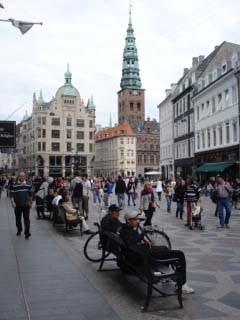 - Copenhagen: The weather was variable but could not hide the attractions of this large city with its felicitous mixture of old and new, its waterways, and architecture combining unique spires and rooftop decorations atop impressive institutional buildings and palaces bespeaking the influence once enjoyed by this once powerful regional state. The population made heavy use of bicycles, propelled at high speed by often well dressed riders.Though jetlagged, we recovered at the Opera Hotel, conveniently located near the western end of a long pedestrian mall that took us through the city centre and on which we enjoyed an expensive coffee, sharing one meal. Of particular interest was the National Museum because of a lengthy and often beautiful exhibit taking the visitor through Denmark’s economic, technological and social development, its political ups and downs, its empire and bittersweet rivalry with Sweden and many other facets of a development every bit as complex and impressive as that of bigger European countries. One gained some impression of what separated but also joined the various Scandinavian countries, whose populations amount to an appreciable almost twenty-five millions. In the face of this history and modernity, respect increased! Our short initial stay whetted our appetite for a second meeting after the cruise.
- Copenhagen: The weather was variable but could not hide the attractions of this large city with its felicitous mixture of old and new, its waterways, and architecture combining unique spires and rooftop decorations atop impressive institutional buildings and palaces bespeaking the influence once enjoyed by this once powerful regional state. The population made heavy use of bicycles, propelled at high speed by often well dressed riders.Though jetlagged, we recovered at the Opera Hotel, conveniently located near the western end of a long pedestrian mall that took us through the city centre and on which we enjoyed an expensive coffee, sharing one meal. Of particular interest was the National Museum because of a lengthy and often beautiful exhibit taking the visitor through Denmark’s economic, technological and social development, its political ups and downs, its empire and bittersweet rivalry with Sweden and many other facets of a development every bit as complex and impressive as that of bigger European countries. One gained some impression of what separated but also joined the various Scandinavian countries, whose populations amount to an appreciable almost twenty-five millions. In the face of this history and modernity, respect increased! Our short initial stay whetted our appetite for a second meeting after the cruise.
 -Stockholm: Tim had visited the Swedish capital twice, deplaning at the airport and noticing the similarities to Canada. Now, the arrival by sea brought something new and beautiful: the approaches through a narrow channel separating the mainland and islands occupied by impressively picturesque summer houses, illustrating the apparent ease, sometimes even opulence, of the way of life of many Swedes and as a climax the truly beautiful spectacle of this capital’s city centre, with its historic buildings, magnificent hotels and palaces, coloured facades, greenery and omnipresent waterways. Our outing was limited, taking in mainly the royal palace and related ceremonies and a boat tour, but under sunny skies it was all very impressive and agreeable. We missed greater acquaintance with the imagined complexities of Swedish life so well hinted at in the movies of Bergmann and the novels of Stieg Larsson and Kurt Wallander. Optically, Stockholm came across that day as the most impressive of all the Scandinavian capitals. More time required!
-Stockholm: Tim had visited the Swedish capital twice, deplaning at the airport and noticing the similarities to Canada. Now, the arrival by sea brought something new and beautiful: the approaches through a narrow channel separating the mainland and islands occupied by impressively picturesque summer houses, illustrating the apparent ease, sometimes even opulence, of the way of life of many Swedes and as a climax the truly beautiful spectacle of this capital’s city centre, with its historic buildings, magnificent hotels and palaces, coloured facades, greenery and omnipresent waterways. Our outing was limited, taking in mainly the royal palace and related ceremonies and a boat tour, but under sunny skies it was all very impressive and agreeable. We missed greater acquaintance with the imagined complexities of Swedish life so well hinted at in the movies of Bergmann and the novels of Stieg Larsson and Kurt Wallander. Optically, Stockholm came across that day as the most impressive of all the Scandinavian capitals. More time required!
 - Helsinki: Knowing of Sibelius’ music, Nokia, Finland’s heroic defense against Russian invaders and this city’s status as the long-time refuge used by western embassy personnel in communist Moscow, we were curious to go beyond the clichés. Time did not, however, allow more than a lengthy streetcar tour through various parts of town, but that served to show us many impressive districts reflecting acceptable prosperity, an emphasis on parks, a mixture of traditional nineteenth century buildings and many newer ones, and an evidently industrious and seemingly happy enough population speaking a non-Indo-european language along with some English (though less than in Denmark and Sweden). We had refreshments at a traditional coffee house on the main drag, looked at examples of Finnish design in clothing and admired the striking Lutheran cathedral. The half day available to us was insufficient, but left us with warm feelings and plenty of curiosity.
- Helsinki: Knowing of Sibelius’ music, Nokia, Finland’s heroic defense against Russian invaders and this city’s status as the long-time refuge used by western embassy personnel in communist Moscow, we were curious to go beyond the clichés. Time did not, however, allow more than a lengthy streetcar tour through various parts of town, but that served to show us many impressive districts reflecting acceptable prosperity, an emphasis on parks, a mixture of traditional nineteenth century buildings and many newer ones, and an evidently industrious and seemingly happy enough population speaking a non-Indo-european language along with some English (though less than in Denmark and Sweden). We had refreshments at a traditional coffee house on the main drag, looked at examples of Finnish design in clothing and admired the striking Lutheran cathedral. The half day available to us was insufficient, but left us with warm feelings and plenty of curiosity.
 - The opportunity to visit St. Petersburg was for the us the chief initial drawing card of a Baltic cruise. The result justified the trip, despite several minor reservations. On the positive side, though everything corresponded to pictures and movies one had seen, we came away impressed by the sheer extent of the Czarist capital’s acreage of palaces, squares, monuments and cathedrals. No wonder the downtrodden masses revolted!
- The opportunity to visit St. Petersburg was for the us the chief initial drawing card of a Baltic cruise. The result justified the trip, despite several minor reservations. On the positive side, though everything corresponded to pictures and movies one had seen, we came away impressed by the sheer extent of the Czarist capital’s acreage of palaces, squares, monuments and cathedrals. No wonder the downtrodden masses revolted!
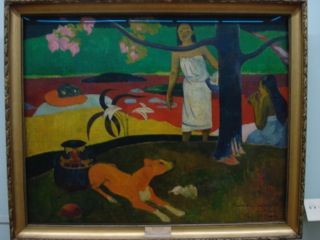 The Hermitage was the highlight, and we had the good fortune to have an excellent, artistically knowledgeable guide. It was a Saturday, and the heavy crowds, we were told, were not as bad as usual. Most of the Hermitage was not constructed with museum purposes in mind so the exhibits are not presented with the skill and visual props common in the best western institutions, but the holdings and quality of paintings are incomparable and seemingly endless. “Vaut le voyage”. The second day was not as good: the Catherine Palace, an hour away, is beautiful and a must, its park pleasantly extensive but pleasantly simple, but the Peterhof – very crowded on a Sunday –an unnecessary duplication. Again, however, the guide – different from the previous day’s – was very competent. New country villas and suburban developments reflected the wealth of a new business class. For political junkies, there was little nourishment in a brief incursion of this kind. However, the two guides conveyed their happiness at greater freedom of speech, a desire for international understanding and hopes that material things would continue to improve. The urban scene around St. Petersburg was of course noticeably less opulent than in Scandinavia – in fact the presence of lots of able bodied men selling trinkets in many places suggested poverty - but consumer goods, cars and advertising suggested an upturn in the standard of living and opportunities, no doubt much more so than in the countryside. Again, even an all-too-brief visit of this kind stimulates one’s interest and attentiveness.
The Hermitage was the highlight, and we had the good fortune to have an excellent, artistically knowledgeable guide. It was a Saturday, and the heavy crowds, we were told, were not as bad as usual. Most of the Hermitage was not constructed with museum purposes in mind so the exhibits are not presented with the skill and visual props common in the best western institutions, but the holdings and quality of paintings are incomparable and seemingly endless. “Vaut le voyage”. The second day was not as good: the Catherine Palace, an hour away, is beautiful and a must, its park pleasantly extensive but pleasantly simple, but the Peterhof – very crowded on a Sunday –an unnecessary duplication. Again, however, the guide – different from the previous day’s – was very competent. New country villas and suburban developments reflected the wealth of a new business class. For political junkies, there was little nourishment in a brief incursion of this kind. However, the two guides conveyed their happiness at greater freedom of speech, a desire for international understanding and hopes that material things would continue to improve. The urban scene around St. Petersburg was of course noticeably less opulent than in Scandinavia – in fact the presence of lots of able bodied men selling trinkets in many places suggested poverty - but consumer goods, cars and advertising suggested an upturn in the standard of living and opportunities, no doubt much more so than in the countryside. Again, even an all-too-brief visit of this kind stimulates one’s interest and attentiveness.
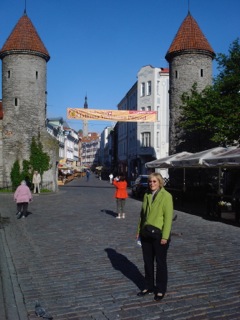 - Tallinn: Only half a day but it sufficed to convey a hint of the beauty of the old city and a hint of the progressive development of this tiny republic as it continues to emerge from the Soviet embrace. The centre goes back to the era of the Hanseatic League and domination by a German merchant and landowning class. Its architectural plethora of restored palaces, villas, churches and squares makes the visit well worth it, while the mélange of poor Russian beggars, trinkets and occasional Cyrillic signs remind the visitor of the none-too- distant past. Signs of western investment were evident in the extensive port facilities and the growing new town. Less than a million Esthonians – what a triumph to have regained their independence!
- Tallinn: Only half a day but it sufficed to convey a hint of the beauty of the old city and a hint of the progressive development of this tiny republic as it continues to emerge from the Soviet embrace. The centre goes back to the era of the Hanseatic League and domination by a German merchant and landowning class. Its architectural plethora of restored palaces, villas, churches and squares makes the visit well worth it, while the mélange of poor Russian beggars, trinkets and occasional Cyrillic signs remind the visitor of the none-too- distant past. Signs of western investment were evident in the extensive port facilities and the growing new town. Less than a million Esthonians – what a triumph to have regained their independence!
 - Gdansk: We were curious about this stop, not least because of the invitations of our departed friend Witold Weynerowski that we never found time to accept. We now understand why he regularly took friends to see the city centre of Gdansk. The resurrected area, larger than a mere square once seen in Warsaw or the small core in Havana, was indeed lovingly restored. Ornate four or five story burghers’ houses and the original styling of their rich and variously painted colourful facades adorned the main pedestrian thoroughfare, while substantial bridges crossed the main canals and impressive religious and commercial institutions testified to the city’s importance. Those who know Luebeck or other Hanseatic cities would feel at home here, and indeed the German heritage – not mentioned by the guide – was evident in some of the restored plaques and statues in the principal cathedral. The guide naturally laid great stress on the heritage of Solidarnosc, the heroic shipbuilding union that defied the military regime and played such a role in Poland’s eventual recovery of independence and democracy. We saw Lech Walesa’s villa amongst others in the leafy suburb of Sopot, reflecting the degree of prosperity once enjoyed by this area and which it may be on the way to recovering. In the wonderfully sunny weather we enjoyed throughout the trip, one felt this was Europe and that, despite the signs of derilect old buildings and workaday clothing, these people seemed on the march. Unlike that in St. Petersburg, our lunch was excellent, and our credit card accepted. Again, these were very superficial impressions, though positive.
- Gdansk: We were curious about this stop, not least because of the invitations of our departed friend Witold Weynerowski that we never found time to accept. We now understand why he regularly took friends to see the city centre of Gdansk. The resurrected area, larger than a mere square once seen in Warsaw or the small core in Havana, was indeed lovingly restored. Ornate four or five story burghers’ houses and the original styling of their rich and variously painted colourful facades adorned the main pedestrian thoroughfare, while substantial bridges crossed the main canals and impressive religious and commercial institutions testified to the city’s importance. Those who know Luebeck or other Hanseatic cities would feel at home here, and indeed the German heritage – not mentioned by the guide – was evident in some of the restored plaques and statues in the principal cathedral. The guide naturally laid great stress on the heritage of Solidarnosc, the heroic shipbuilding union that defied the military regime and played such a role in Poland’s eventual recovery of independence and democracy. We saw Lech Walesa’s villa amongst others in the leafy suburb of Sopot, reflecting the degree of prosperity once enjoyed by this area and which it may be on the way to recovering. In the wonderfully sunny weather we enjoyed throughout the trip, one felt this was Europe and that, despite the signs of derilect old buildings and workaday clothing, these people seemed on the march. Unlike that in St. Petersburg, our lunch was excellent, and our credit card accepted. Again, these were very superficial impressions, though positive.
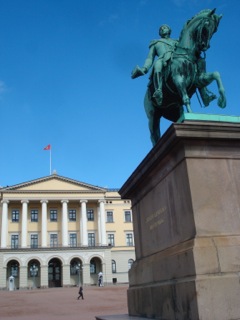 - Oslo: Having once been offered a Head-of-Post job in Norway (declined because inconvenient), Tim was particularly interested to glimpse the capital of this small but very prosperous country. As the books suggested, a stroll on foot from the dock through central Oslo gave some impressions. The impressive layout of its principal ceremonial avenue, the measured size of its attractive but simple royal palace and small gardens, the attractive municipal opera theatre, the excellent national gallery and the seemingly leisured but purposive temper of urban life sufficed to create a very attractive package. Beautiful blonds completed the pleasant picture. A Canadian tourist exhibition at the harbour may have been money not well spent, but a most well-spoken Norwegian public affairs officer was convincing evidence of the quality of local personnel. No trolls here!
- Oslo: Having once been offered a Head-of-Post job in Norway (declined because inconvenient), Tim was particularly interested to glimpse the capital of this small but very prosperous country. As the books suggested, a stroll on foot from the dock through central Oslo gave some impressions. The impressive layout of its principal ceremonial avenue, the measured size of its attractive but simple royal palace and small gardens, the attractive municipal opera theatre, the excellent national gallery and the seemingly leisured but purposive temper of urban life sufficed to create a very attractive package. Beautiful blonds completed the pleasant picture. A Canadian tourist exhibition at the harbour may have been money not well spent, but a most well-spoken Norwegian public affairs officer was convincing evidence of the quality of local personnel. No trolls here!
In summary, we were favourably impressed by this trip. Of course, the good weather helped. While it was frustrating to have so little time and gain only very superficial impressions, what we did see was interesting as far as it went. The prosperity and beauty of Scandinavian capitals is evidence of achievements, though clearly they share many of our problems as well. National museums and galleries were interesting both to sample the ways these countries present themselves and to view great paintings. One’s curiosity is aroused. Life on board (and the food) was agreeable, the administrative side well handled. Our appetite for cruises has increased.
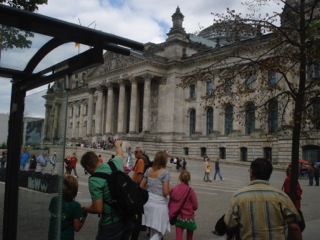 The six-day Berlin aftermath was also a highlight. Gloria spent much of the time with her former school comrades, a unique experience after almost half a century. Both of us enjoyed a photography exhibit at the German National Historical Museum, several outings into the countryside in the company of her brother Frank Hagemann, and a good performance of Offenbach’s Tales of Hoffmann at the Comic Opera. Downtown Berlin (“Mitte”) now seems overwhelmingly prosperous and institutionally impressive, with crowds enjoying outdoor cafes on Unter den Linden, in the beautiful Gendarmenmarkt or in many other locales beside the rivers and canals criss-crossing the centre. The National Gallery of Modern Art is now open again and offers a thrilling permanent collection of expressionist German art. Politics was everywhere in that, as in so many buildings themselves. The local newspapers having listed free lectures on their cultural sections, Tim found time to attend two of them, one on the justice meted out – or not – to officials of the former German Democratic Republic, the other on the ambiguities in the interpretation of historical photographs. In addition to seeing two plays and locating a good second-hand bookstore, he met with former friends of his “Round Table” circle of 1963-66, who included a historian, a German-American theatre director and a businessman. The latter is of East Indian origin, the creator of a successful Berlin engineering company. This detail coincided with the evident internationalization of the German population, now teeming with immigrants from the Third World and eastern and southern Europe, many speaking German with each other. As usual, the everyday news was of interest – the difficulties of coalition building, the travails of economic adjustment and the challenges to be faced with others at the upcoming Economic Summit. Altogether, a gripping week in a fascinating city.
The six-day Berlin aftermath was also a highlight. Gloria spent much of the time with her former school comrades, a unique experience after almost half a century. Both of us enjoyed a photography exhibit at the German National Historical Museum, several outings into the countryside in the company of her brother Frank Hagemann, and a good performance of Offenbach’s Tales of Hoffmann at the Comic Opera. Downtown Berlin (“Mitte”) now seems overwhelmingly prosperous and institutionally impressive, with crowds enjoying outdoor cafes on Unter den Linden, in the beautiful Gendarmenmarkt or in many other locales beside the rivers and canals criss-crossing the centre. The National Gallery of Modern Art is now open again and offers a thrilling permanent collection of expressionist German art. Politics was everywhere in that, as in so many buildings themselves. The local newspapers having listed free lectures on their cultural sections, Tim found time to attend two of them, one on the justice meted out – or not – to officials of the former German Democratic Republic, the other on the ambiguities in the interpretation of historical photographs. In addition to seeing two plays and locating a good second-hand bookstore, he met with former friends of his “Round Table” circle of 1963-66, who included a historian, a German-American theatre director and a businessman. The latter is of East Indian origin, the creator of a successful Berlin engineering company. This detail coincided with the evident internationalization of the German population, now teeming with immigrants from the Third World and eastern and southern Europe, many speaking German with each other. As usual, the everyday news was of interest – the difficulties of coalition building, the travails of economic adjustment and the challenges to be faced with others at the upcoming Economic Summit. Altogether, a gripping week in a fascinating city.
Tags: Tim Williams
